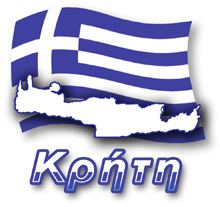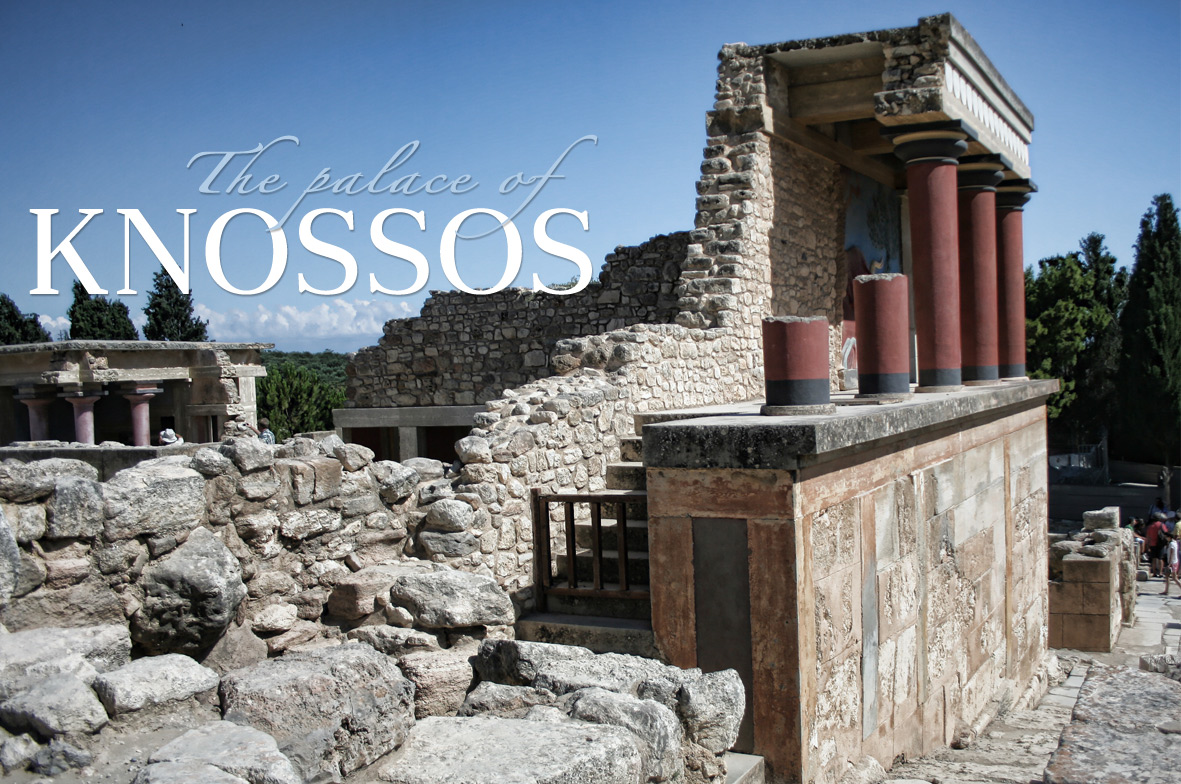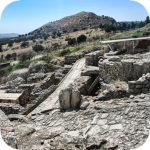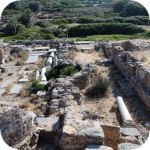
It is 1878, when a Greek merchant and antiquarian Minos Kalokairinos discovers the ruins of Knossos and performs the first works revealing part of the western facade of the palace. However, it was not until 16 March 1900 that Sir Arthur Evans, after purchasing the whole hill, carried out extensive excavations discovering perhaps the greatest treasure of Crete. This English gentleman, thanks to his own large financial outlays, in a few months discovered a significant part of the building, which was appointed by him the palace of Minos. However, Evans did not conduct these excavations alone, because he was a typical self-taught person who did not have adequate theoretical knowledge. Knossos was supported by experienced archaeologist Dr Duncan Mackenzie (known for example from excavations on the island of Melos) and Fyfe architect from the British School in Athens.

Knossos is more than a thousand interconnected rooms with very diverse functions, ranging from craft workshops to food warehouses and rooms that perform religious functions. The most famous of these is the central Throne Room, decorated with very characteristic and recognizable paintings. Unfortunately, the current frescoes are largely a vision of two painters (father and son bearing the same name), Émile Gilléron, who, on the order of Evans, recreated wall paintings of poor remnants as they survived.
The Grand Palace was built for almost 300 years, starting from 1700 BC. During this period it was subject to unavoidable reconstructions. The present remains of the palace depict its ruins from the late Minoan period. In the space of about 24,000 m 2 , the theater, many warehouses and around 1,300 rooms were located, which were connected by corridors running in different directions of the palace. This building had 4 separate entrances, which were separate main gates for each side of the palace.

Stairs at the Theater
The palace was very functional in terms of functionality. With the help of a complicated water supply system, many rooms had access to running water. In Knossos there is also one of the first toilets, in which the shell was rinsed with water. Due to heavy rains that haunt this place, the palace was equipped with a complicated drainage system.
One of the more characteristic elements associated with the Knossos Palace is the red columns. Although they are currently made of concrete, they were originally made of cypress trunk. In contrast to the stone columns typical of Greek architecture, the columns from Knossos are narrower at the bottom and wider at the top. The reverse proportions of the columns result from the fact that before setting in a stone pedestal, the trunk was rotated. This action was to prevent the re-development of the felled tree.
The room, which is the central part of this Mycenaean palace, was described by Evans as Throne Room (or Throne Room). On three sides of the room there are plaster benches, and an alabaster seat, built in the northern wall, which Evans pointed out as a throne. This room is decorated with frescoes depicting two griffins in a lying position. These mythical animals have a special meaning in the culture of the Mycenaean Greeks. Among other things, based on these frescoes, scientists presume the purpose of this room. According to the two most popular theories there was the seat of the king or a priestess (this is supposed to be a heraldic arrangement of painted griffins), or it was a room of a religious character (the griffin symbolizes divinity in this case).

Throne Room with an alabaster trone
Knossos is one of the flagship monuments visited by tourists, it is also the most popular estatejsce, to which organized trips go. In the high season you have to reckon with a large number of people and a large crowd in what more attractive parts of this extensive excavation. For sure, you should not be surprised by the queue to the Throne Hall. It may happen that you will be forced to stay a dozen or a few dozen minutes long in the long tail of other tourists willing to visit this room. Well, in the height of the season, the legend of the labyrinth of Knossos attracts a really large number of people and the only sensible way for a relatively comfortable tour is to come to this place in the early morning hours, or more or less at lunchtime.
Independent access to Knossos is not a major problem. Regardless of where you are, you should follow the New National Road to Heraklion , then, approximately half way along the beltway surrounding the city, take one of the exits towards Skordalou Thanasi. After about 300 meters you will reach the road (named Knossou Leof) that connects directly to Heraklion from Knossos, about 3 km away. Anyway, it will be rather hard for you to miss the right exit and the road to Knossos, because the access is very well marked with the appropriate direction indicators.

Emerging car parks are the announcement that you are approaching excavations. Owners of some car parks do not charge, and the only salary they expect (but do not require) is to use the services of their tavern. Ultimately, this is not such a bad deal, because drinking something cold (for example Frappe) after a visit to Knossos is even indicated. Due to the vastness and heated open space, exploring the maze of Minos can get really tired. It's hard to rest here from the sun's rays, so take a bottle of mineral water with you.
Visiting Knossos is quite expensive, the ticket costs 15 €. Paid toilets are also paid, although the principle of grace is accepted here. As for Crete, it is quite peculiar and unique, because nowhere else did we meet with a similar approach. On the plus side, quite long hours of making excavations available to visitors can be considered. This place is open during the tourist season from 8 am to 8 pm. In Knossos there is no ban on taking photographs, and the use of the camera does not involve any additional fees.
↤ click the appropriate part of the island to change the bottom map
Knossos is one of the flagship monuments visited by tourists, it is also the most popular place where organized trips go.
Heraklion (Iraklion) is the largest city of Crete. With almost 140,000 inhabitants, it is the fourth largest city in Greece.
Dozens of craft workshops located in this small mountain village make Margarites one of the four main centers where traditional Cretan ceramics are made.
International airport. Nikos Kazantzakis in Heraklion is currently the largest airport in Crete.
Heraklion (Iraklion) is the largest city of Crete. With almost 140,000 inhabitants, it is the fourth largest Greek city.
The date of the foundation of Moni Arkadiou (Arkadi) is not exactly known. According to tradition, the name of this church refers to the name of the Emperor Arkadiusz, who supposedly was to be its founder.
The date of the foundation of Moni Arkadiou (Arkadi) is not exactly known. According to tradition, the name of this church refers to the name of the Emperor Arkadiusz, who supposedly was to be its founder.
Rethymnon with around 40,000 inhabitants are the third largest city of Crete. This place was populated already in the Minoan period. Historically, the city was an important commercial center.
Thrapsano is a small town inhabited by slightly over 2,500 people, the vast majority of which until recently maintained their activity as a potter.
Skinaria is a small beach located along a small bay, whose outlet on both sides ends with a rocky coast. It is still a little-known place overlooked by mass tourism
Skinaria is a small beach located along a small bay, whose outlet on both sides ends with a rocky coast. It is still a little-known place overlooked by mass tourism
According to Greek mythology, Zeus hid (and perhaps even gave birth) in the Ida cave. This myth is the greatest asset of this cave, which is not as interesting and beautiful as the Dikte cave.
Tripiti is a small beach covered with a mixture of gray sand, gravel and stones. Despite the fact that the beach is unorganized and has a semi-natural appearance, one small tavern works here.
Tripiti is a small beach covered with a mixture of gray sand, gravel and stones. Despite the fact that the beach is unorganized and has a semi-natural appearance, one small tavern works here.
Tripiti is a small beach covered with a mixture of gray sand, gravel and stones. Despite the fact that the beach is unorganized and has a semi-natural appearance, one small tavern works here.
Plakias is a perfect place for people who like to spend time hiking. In the area of the town and the surrounding area, there are several hiking trails that lead to interesting beaches.
Currently, the lower monastery is still not open to the public and is not used by the monks. The buildings of the upper monastery have undergone partial renovation and are the main seat of the Preveli monastery.
Currently, the lower monastery is still not open to the public and is not used by the monks. The buildings of the upper monastery have undergone partial renovation and are the main seat of the Preveli monastery.
Currently, the lower monastery is still not open to the public and is not used by the monks. The buildings of the upper monastery have undergone partial renovation and are the main seat of the Preveli monastery.
The Kourtaliotiko Gorge, also known as the Asomatos Gorge, is perhaps one of the most spectacular natural attractions available in the central part of Crete.
Agia Triada is a small Minoan archaeological site in the south of Crete, located near Timpaki, located on the western slope of the hill about 40 meters above sea level.
Około 60 kilometrów na południowy zachód od stolicy Krety - Heraklionu znajdują się ruiny drugiego co do wielkości starożytnego pałacu - Fajstos.
Currently, Melidoni Cave (originally called Gerontospilios) is associated mainly with the tragic events that took place here in 1824.
This fortress is a perfect example of Crete's multiculturalism. Located today in Greek hands, it was built by the Venetians, but is called a name taken from the Turkish language.
It is one of the most important and largest museums in Greece and one of the most important in Europe.
Tylissos is one of the few places in Crete that has kept its name since ancient times.
Plaża w Damnoni jest położona po sąsiedzku z Plakias - popularną turystyczną miejscowością
Agios Pavlos is a small town located on the southern coast of Crete near Saktouria.
Triopetra is located at the foot of the Siderotas mountain about 52 km south of Rethymno.
gia Galini (Αγία Γαλήνη) jest jednym z najpopularniejszych nadmorskich kurortów na południowym wybrzeżu Krety.
The observatory is located at the top of the Skinakas mountain at an altitude of 1750 m. The idea for its construction was born in 1984.
The Late-Romanesque cemetery in Armeni is located on the outskirts of this town, located less than 10 km south of the center of Rethymno.
The museum presents the dramatic history of Crete written over the last several hundred years.
The modern settlement known as Argyroupolis was built on the site of the ancient city of Lappa (also called Lambi)
Lentas is a good idea for those who want to get away from villages steeped in industrial tourism.
This ancient quarry, consisting of two parts by modern times, is called Λαβυρινθάκι and Λαβύρινθος.
If anyone of you is looking for a good restaurant near Matala and Kalamaki, then we would like to recommend estiório Chrisopigi.
Psiloritis (Timios Stavros - Holy Cross) is the top of the highest mountain of Crete, rising to 2456 m above sea level.
Rouvas Gorge is one of the most interesting places in this part of Crete. The interesting trail leads in a perfect way to the changing appearance of this gorge.
Matala is one of the most popular towns not only of the southern coast but also of the whole of Crete. In the 1960s and 1970s, this small fishing village was a mecca for hippies.
The Odigitrias Monastery is one of the most famous monasteries of southern Crete. Unfortunately, in terms of popularity, he is far from other Cretan monasteries.
Kali Limenes (meaning Dobre Porty or Piękny Przystanie) is a coastal town located in the Asterousia Mountains on the southern coast of Crete.
In addition to the famous grand palaces on the island in the Minoan period, a number of smaller residences were created. One of the most important examples is the Vathipetro discovered about 5 km north of Archanes, on the southeastern slope of Mount Juchtas in the central part of Crete.
When traveling around Crete, it is not difficult to pay attention to the fact that most of the beaches there are relatively small and short. For this reason, people who are used to our national Baltic standards, where the sandy coast stretches for kilometers, may experience a special disappointment. However, fortunately, nothing is lost, because Crete in its rich arsenal of various beaches can boast of those that allow for long walks along the coast. One of them, our favorite is the Kommos beach located in the south of the central part of the island.
Although there are countless caves in Crete, only a few can be visited. Sfendoni is the largest cave open to the public. content comes from: http://www.crete.pl www.CRETE.pl
The old Venetian port and the lighthouse are one of the most recognizable elements of Rethymno.

About 60 kilometers southwest of the capital of Crete - Heraklion are the ruins of the second largest ancient palace - Phaistos. Visiting the various Minoan palaces of Crete, it is impossible not to compare them with each other, and in the case of Phaistos comparing it with the most famous Minoan Knossos imposes itself. In my opinion, it falls out of favor for the palace in Phaistos.
Redirected from the site - Káto Zákros (Ζάκρος). Zakros is the fourth-largest Minoan palace in Crete in importance and size. This latest found, built on the east coast of the island is located in the village of Káto Zákros. Rocky mountains surround the ruins of the palace complex with the remains of a once thriving city, built on a fairly hard-to-reach and inhabited area. Paradoxically, Zakros, being several centuries ago, a city with extensive contacts with other countries, was (and is actually still) the most isolated Minoan center on the island.

The ruins of the ancient city of Itanos are located at the eastern tip of Crete, less than 3 kilometers north of the famous palm beach of Vai. Although there are also nice beaches at Itanos, unlike its well-known neighbor, this place does not attract crowds. There are either accidental stray tourists or excavation enthusiasts here.
Komentarze
Ceny
Bilet wstępu kosztuje 6€, ale jeśli jesteś studentem lub osobą uczącą się wejście masz za darmo. Wystarczy tylko pokazać polską legitymację studencką lub szkolną i osoba w kasie podaruje Ci darmowy bilet i powie "Miłego zwiedzania" w naszym języku ;) Toaleta nie jest już co łaska, przyjemność ta kosztuje 0,50€.
Wrażenie
Każdy ma własne zdanie , dla mnie to nie było zwiedzanie atrakcyjne. Moze kiedyś coś tam było fajnego, teraz kamień na kamieniu. To miejsce potraktowałam jako coś do "zaliczenia". Generalnie mnie nie porwało wcale. Trzeba mieć sporo wyobraźni żeby coś wykrzesać. Wg. mnie przereklamowane a jedzie się tam ze względu na ....historię .
Wypełnij poniższy formularz aby dodać komentarz